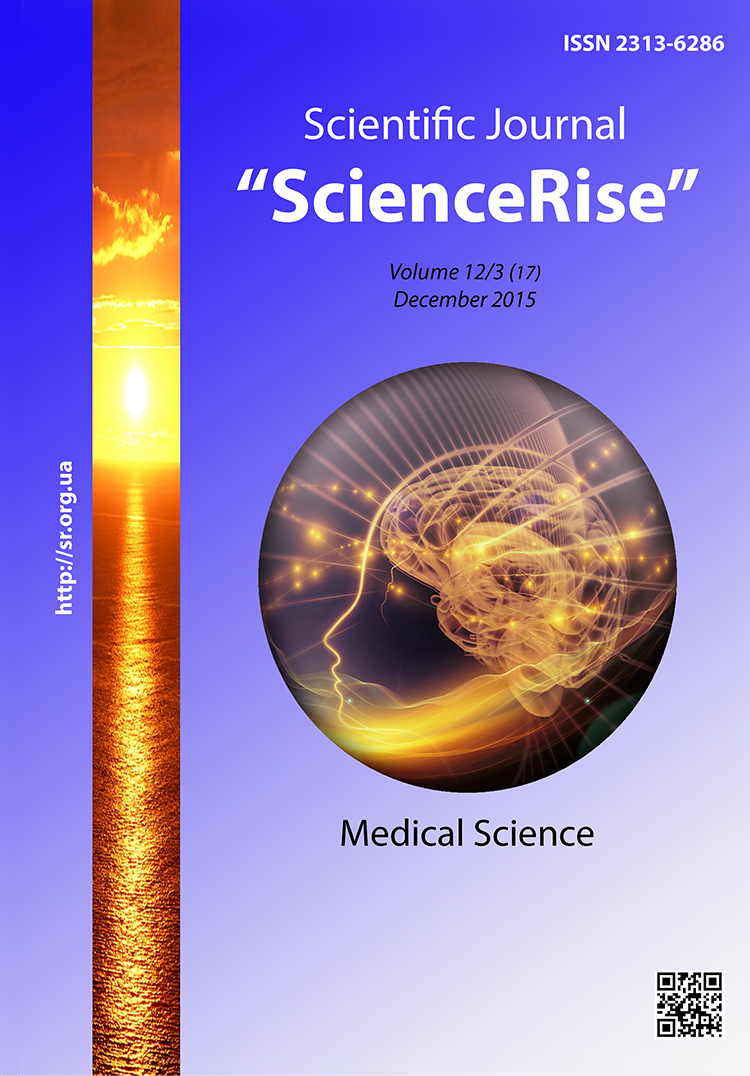Роль маркерів системної протизапальної відповіді у патогенезі хронічної ішемії нижніх кінцівок
DOI:
https://doi.org/10.15587/2313-8416.2015.56807Ключові слова:
хронічна ішемія, нижні кінцівки, маркери системної запальної відповіді, атеросклероз, гіпоксіяАнотація
Вивченнядинаміки: маркерівсистемноїзапальноївідповіді, білка HIF-1, внутріклітинноговмістувуглеводнихсубстратів–маркерівпентозо-фосфатногоциклуприхронічнійкритичнійішеміїнижніхкінцівоктахарактерутранскрипціївексперименті. Динамікабілка HIF-1 вцитоплазмім`язовоїклітинидемонструє, щогіпоксіяєбільштяжкоюзарахуноксиндрому«взаємногообтяження»міжішемізованоюкінцівкоюіорганами-мішенямиПосилання
Dopheide, J. F., Geissler, P., Rubrech, J., Trumpp, A., Zeller, G. C., Bock, K. et. al (2015). Inflammation is associated with a reduced number of pro-angiogenic Tie-2 monocytes and endothelial progenitor cells in patients with critical limb ischemia. Angiogenesis. doi: 10.1007/s10456-015-9489-y
Halvorsen, Y., Wilkison, W., Gimble, J. (2000). Adipose-derived stromal cells—their utility and potential in bone formation. International Journal of Obesity, 24, S41–S44. doi: 10.1038/sj.ijo.0801503
Pant, S., Deshmukh, A., GuruMurthy, G. S., Pothineni, N. V., Watts, T. E., Romeo, F., Mehta, J. L. (2013). Inflammation and Atherosclerosis--Revisited. Journal of Cardiovascular Pharmacology and Therapeutics, 19 (2), 170–178. doi: 10.1177/1074248413504994
Pande, R. L., Brown, J., Buck, S., Redline, W., Doyle, J., Plutzky, J., Creager, M. A. (2015). Association of monocyte tumor necrosis factor α expression and serum inflammatory biomarkers with walking impairment in peripheral artery disease. Journal of Vascular Surgery, 61 (1), 155–161. doi: 10.1016/j.jvs.2014.06.116
Haas, T. L., Lloyd, P. G., Yang, H.-T., Terjung, R. L.; Terjung, R. (Ed.) (2012). Comprehensive Physiology. USA: John Wiley & Sons, Inc., 2933–3017.
De Graaff, J. C., Ubbink, D. T., Legemate, D. A., de Haan, R. J., Jacobs, M. J. H. M. (2001). Interobserver and intraobserver reproducibility of peripheral blood and oxygen pressure measurements in the assessment of lower extremity arterial disease. Journal of Vascular Surgery, 33 (5), 1033–1040. doi: 10.1067/mva.2001.108011
Chavakis, E., Dimmeler, S. (2011). Homing of Progenitor Cells to Ischemic Tissues. Antioxidants & Redox Signaling, 15 (4), 967–980. doi: 10.1089/ars.2010.3582
8. Mahe, G., Liedl, D. A., McCarter, C., Shepherd, R., Gloviczki, P., McPhail, I. R. et. al (2014). Digital obstructive arterial disease can be detected by laser Doppler measurements with high sensitivity and specificity. Journal of Vascular Surgery, 59 (4), 1051–1057.e1. doi: 10.1016/j.jvs.2013.10.076
Jaipersad, A. S., Lip, G. Y. H., Silverman, S., Shantsila, E. (2014). The Role of Monocytes in Angiogenesis and Atherosclerosis. Journal of the American College of Cardiology, 63 (1), 1–11. doi: 10.1016/j.jacc.2013.09.019
Rooke, T. W. Management of patients with peripheral artery disease (compilation of 2005 and 2011 ACCF/AHA Guideline Recommendations): a report of the American College of Cardiology Foundation/American Heart Association Task Force on Practice Guidelines / T. W. Rooke, A. T. Hirsch, S. Misra, A. N. Sidawy, J. A. Beckman, L. Findeiss et. al // Journal of the American College of Cardiology. –2013. – Vol. 61, Issue 14. – P. 1555–1570. doi: 10.1016/j.jacc.2013.01.004
Tendera, M., Aboyans, V., Bartelink, M.-L., Baumgartner, I., Clement, D., Collet, J.-P. et. al (2011). ESC Guidelines on the diagnosis and treatment of peripheral artery diseases: Document covering atherosclerotic disease of extracranial carotid and vertebral, mesenteric, renal, upper and lower extremity arteries * The Task Force on the Diagnosis and Treatment of Peripheral Artery Diseases of the European Society of Cardiology (ESC). European Heart Journal, 32 (22), 2851–2906. doi: 10.1093/eurheartj/ehr211
Willeit, P., Thompson, S. G., Agewall, S., Bergstrom, G., Bickel, H., Catapano, A. L. et. al (2014). Inflammatory markers and extent and progression of early atherosclerosis: Meta-analysis of individual-participant-data from 20 prospective studies of the PROG-IMT collaboration. European Journal of Preventive Cardiology. doi: 10.1177/2047487314560664
##submission.downloads##
Опубліковано
Номер
Розділ
Ліцензія
Авторське право (c) 2015 Олена Ігорівна Кефелі-Яновська, Наталія Юріївна Літвінова, Віктор Анатолійович Черняк, Володимир Григорович Мішалов, Ельвіра Айдинівна Джалілова, Дмитро Дубенко, Тарас Григорович Шевченко

Ця робота ліцензується відповідно до Creative Commons Attribution 4.0 International License.
Наше видання використовує положення про авторські права Creative Commons CC BY для журналів відкритого доступу.
Автори, які публікуються у цьому журналі, погоджуються з наступними умовами:
1. Автори залишають за собою право на авторство своєї роботи та передають журналу право першої публікації цієї роботи на умовах ліцензії Creative Commons CC BY, котра дозволяє іншим особам вільно розповсюджувати опубліковану роботу з обов'язковим посиланням на авторів оригінальної роботи та першу публікацію роботи у цьому журналі.
2. Автори мають право укладати самостійні додаткові угоди щодо неексклюзивного розповсюдження роботи у тому вигляді, в якому вона була опублікована цим журналом (наприклад, розміщувати роботу в електронному сховищі установи або публікувати у складі монографії), за умови збереження посилання на першу публікацію роботи у цьому журналі.

